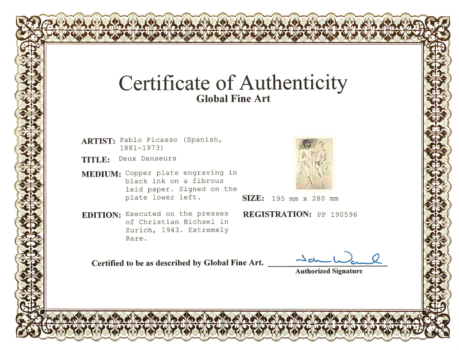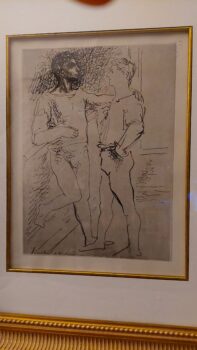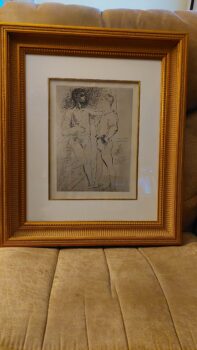This art appraisal report offers an in-depth and impartial assessment of the artwork in question, grounded in the appraiser’s expertise and familiarity with the art market. All the information and data analyzed in this report is sourced solely from the client.
Having a clear understanding of the value of your artwork is crucial in making informed decisions about its future. This report provides a precise estimate of the value of each piece, using US dollars as the base currency. It is not intended to encourage the sale of the artwork, but rather to provide valuable information on how to proceed should the client decide to do so in the future.
Detailed description of the artwork, including its medium, dimensions, and condition.
Checking Originality: Identification with Artificial Intelligence Test
In the quest to identify a match, Image Search employs advanced AI techniques to scour databases of images in order to find visually similar images. This is achieved through the use of various algorithms such as pattern recognition and machine learning. While some results may be considered as “matches” due to a clear similarity, other results may be inconclusive as they rely more on chance rather than any specific similarities. To conduct this test, a front-facing image was used as a reference to search for similar images on the internet.
The results of the automatic recognition are not conclusive. If a match is found, it will be shown below:
What specific information can we obtain from this test?
The algorithm found similar matches, ink drawings and engravings from the same set of Picasso’s artworks. This result is associated with prints, either regular or limited edition prints, that were hand signed by the original artist of this piece of art. It’s important to determine what type you have, so I need to go through the research and inspection process.
Age estimation
When examining a painting such as Pablo Picasso’s Deux Danseurs, circa 1925, there are several characteristics that can be used to determine the age of the piece. The frame construction, the color palette used, and the style of painting can all be used to identify the age of a piece. For example, the frame construction of Deux Danseurs is characteristic of the Art Deco movement, which began around the 1920s, indicating that the painting is likely from this time period. Additionally, the color palette used in the painting is typical of the vibrant, brightly colored hues of the era. Lastly, the style of the painting is that of Picasso’s Cubist period, which he began in 1907, further indicating the painting’s age. All of these characteristics, taken together, suggest that Deux Danseurs was likely painted around 1925.
Based on this information and the pictures provided, I can estimate this painting was made circa 20thC accordingly to the COA.
Condition of the artwork
This Pablo Picasso painting, titled Deux danseurs, circa 1925, is in excellent condition, with no appreciable damages and no need for restoration. If any damage is present, it is minimal. The pen and India ink drawing is a stunning example of Picasso's work during the period, with two dancers in a graceful, swirling pose. This artwork is a beautiful piece and its perfect condition allows it to be appreciated as it was meant to be.
Artist’s name, biographical information, artwork’s provenance (history of ownership) and exhibition history.
I study and research the signature of artwork to see if it matches any known signatures.
Detailed analysis of the artwork’s style, subject matter, and significance within the artist’s oeuvre and the broader art world.
I can check if the style and type of painting match those of the artist referenced.
The painting, likely created around 1925, features an example of the artistic style of Pablo Picasso, a Spanish artist from 1881 to 1973. The work is drawn with pen and India ink and exhibits the artist's characteristic use of line, form, and texture. These elements are used to create a sense of motion, creating an overall abstracted atmosphere. The painting's unique use of color, texture, and depth make it stand out from other works of the period.
Comparable sales information, including prices realized at recent auctions or private sales of similar works by the artist or in the same medium.
In order to provide an up-to-date estimate of the fair market value for the Pablo Picasso (Spanish, 1881–1973) titled Deux danseurs circa 1925 Pen and India Ink Drawing, I utilized the data collected, including auction prices and other relevant market information. This is crucial as it can be used in various contexts such as insurance, estate planning, and art market analysis, as Picasso has been one of the most influential artists of the 20th century. It also offers a valuable insight into how the valuation of Picasso's artwork may have changed due to environmental or economic factors.
The auction prices were a significant factor in determining the current market value of the artwork, as they are based on actual transactions between buyers and sellers in the art market. As such, they are a strong indicator of the expected value of the piece in the near future.
By analyzing auction results from the last 6 months, I was able to accurately determine the current fair market value of the artwork. This approach provides a comprehensive view of how the value has changed over time and gives insight into any potential areas of appreciation or depreciation in its price. Additionally, it allows me to adjust my valuation as new auction prices become available.
Conclusion
Investing in art has long been viewed as a smart move for many reasons. Artwork can appreciate in value over time and is often considered a low-risk asset. Not only does it provide a unique piece of beauty to a collector, but it also can provide a financial return if the market for the specific work appreciates. Additionally, owning art can be a great way to diversify a portfolio and protect against inflation. For example, when inflation hits, the price of artwork tends to remain relatively stable, providing a hedge against inflation. Furthermore, buying a piece of artwork can be a great way to support an artist and their vision. Investing in a piece of art, such as the 1925 Pen and India Ink Drawing by Pablo Picasso, can provide a lasting reminder of the artist and their vision.
Pablo Picasso's Deux danseurs Circa 1925 Pen and India Ink Drawing can be considered valuable by the art market because it is a rare example of Picasso's early work in the 1920s which is a particularly sought-after period of his career. Furthermore, the work itself is an impressive example of Picasso's skill with the pen and ink medium, and its vibrant colors and unique composition make it a particularly attractive work. Additionally, Picasso is one of the most revered and iconic artists of the 20th century, and his works are highly sought-after by collectors and museums alike.
Final Appraisal Value ($)
10,000 $
Appraisal Report made by:
Andrés Gómez
BSc, MSc, Expert Art Appraiser
10+ years of experience in Online Art Appraisals
100k+ Customers Served
Antique Store Owner
You can check my portofolio of past appraisals here:
https://www.appraisily.com/andres-portofolio/

Relevant photographs or supporting documentation, such as condition reports or expert opinions
A detailed summary of the appraisal process and the appraiser’s qualifications.
Insurance replacement value art appraisal is a method used to determine the cost to replace a piece of artwork by an insurance company. This form of appraisal values an artwork based on the cost of replacement offered by the sole provider of these artworks, which is Global Fine Art Print.
In this method, the appraiser considers the cost offered by Global Fine Art Print to replace the artwork. The appraiser does not take into account the artist’s reputation, market conditions, or the condition and age of the artwork, as in mark-to-market art appraisal.
Insurance replacement value art appraisal is used to determine the amount that an insurance company will pay back to a policyholder in the case of loss or damage of an artwork. It helps policyholders receive an appropriate sum for replacement and helps insurers ensure they are not being overcharged.
The appraisal process involves evaluating the item based on information provided by the requester, including photographs and descriptions. The appraiser uses this information to determine the cost of replacement offered by Global Fine Art Print.
A statement of the appraiser’s liability and any potential conflicts of interest.
A qualified art appraisal, also known as a formal written evaluation, is a professional assessment of the monetary value of a piece of art by an individual who has specialized knowledge, expertise, and training in the field of art appraisal. This person must meet certain educational and professional requirements, including experience in researching and evaluating art, as well as knowledge of the art market and current market trends. The purpose of a qualified art appraisal is to provide an objective and unbiased opinion of the value of a piece of art for various purposes, including insurance claims, tax planning, estate planning, or to help determine a fair price for a sale or purchase.
We are committed to providing our clients with the most accurate and unbiased appraisal reports. To ensure impartiality, we adopt a flat rate, fixed fee structure for all appraisals, instead of a percentage-based fee. This eliminates any potential conflicts of interest between the art appraiser and the final report value. Our appraisal reports are in compliance with the Appraisal Foundation’s USPAP (Uniform Standards of Professional Appraisal Practice) standards and guidelines, which are widely accepted as the ethical and performance standards for appraisers. This guarantees that our reports are of high quality and legally defensible.
How to sell this artwork.
We have a structured guide to help you sell your artwork, you can find it here.











